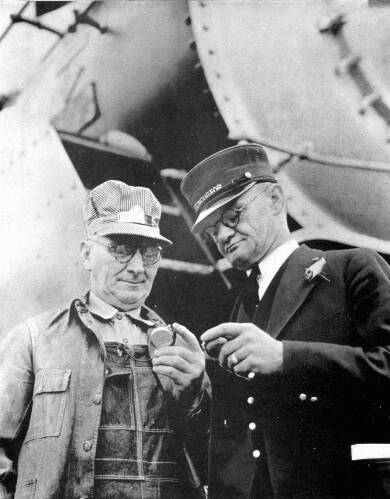|
The Conductor and Engineer Compare
Watches
 Time is a factor of major importance
in railway operations. Every one of the thirty-five thousand passenger
and freight trains operated daily on the American railroads must
move and meet and pass and arrive and depart on a definite time
schedule. If a train falls behind its set schedule, it must run
on a delayed time schedule. Time is a factor of major importance
in railway operations. Every one of the thirty-five thousand passenger
and freight trains operated daily on the American railroads must
move and meet and pass and arrive and depart on a definite time
schedule. If a train falls behind its set schedule, it must run
on a delayed time schedule.
Train crews, station employees, and numerous other railroad
men must report for duty and perform their assigned tasks on a
definite schedule. Locomotives must be put in readiness, cars
must be assembled, trains must be made up, stations, ticket offices,
baggage rooms and mail and express offices must be opened and
closed according to schedules. Foremen in charge of track repairs
must know when each train is due to pass over his section so that
the track will be in readiness.
On each railroad there are designated standard clocks which
are corrected daily to conform with the time signals telegraphed
throughout the country from the United States Naval Observatory
in Washington, D. C. At no time are these clocks allowed to deviate
more than ten seconds from Naval Observatory time. At points on
the railroad where these precision clocks are not installed, railroad
clocks must not deviate more than 30 seconds from standard time.
Unless otherwise provided in railroad rules, watches carried
by train dispatchers, conductors, enginemen, brakemen, yardmasters
and foremen of yard engines must be compared with a designated
standard clock before commencing each day's work.
Conductors and enginemen always compare their watches before
starting on a run or before commencing work each day, and other
members of the train crew must compare their watches with the
conductor's or engineman's watch at the first opportunity.
Employees who are required to carry approved standard watches
and have them regularly cleaned and inspected include trainmasters,
train dispatchers, station agents, telegraph operators handling
train orders, yardmasters, road and yard conductors, engineers,
firemen, brakemen, switchmen, road foremen of engines, train baggagemen,
track supervisors, section foremen, supervisors of bridges and
buildings, signal supervisors, signal foremen, and foremen of
crews working on bridges, buildings and roadways.
Prior to 1883, cities and towns throughout the United States
went by "sun" time, and since it requires about 195
minutes for the sun's meridian to pass across the United States
from Eastport, Maine, to Cape Flattery, Washington, there were
about that many different local times in this country.
Each railroad adopted the time standard of one of its principal
cities. In all, the railroads of the United States were operating
on more than 60 different standards of time. This medley of times
created a great deal of confusion.
The railroads "put their heads together" and agreed
to adopt a uniform standard of time in each of four time zones
based upon mean "sun" time on the 75th, 90th, 105th
and 120th meridians west of Greenwich, each time zone being one
hour apart.
At exactly 12 o'clock noon on November 18, 1883, the sixty-odd
railroad times were abolished throughout the United States and
every railroad clock and every railroad man's watch was set to
standard time in each of the four time zones. Cities and towns
in all parts of the country promptly adopted standard time, and
since then standard time has been adopted by the peoples of other
countries until today it is in almost universal use.
I've Been Working
on the Railroad | Contents Page
|







